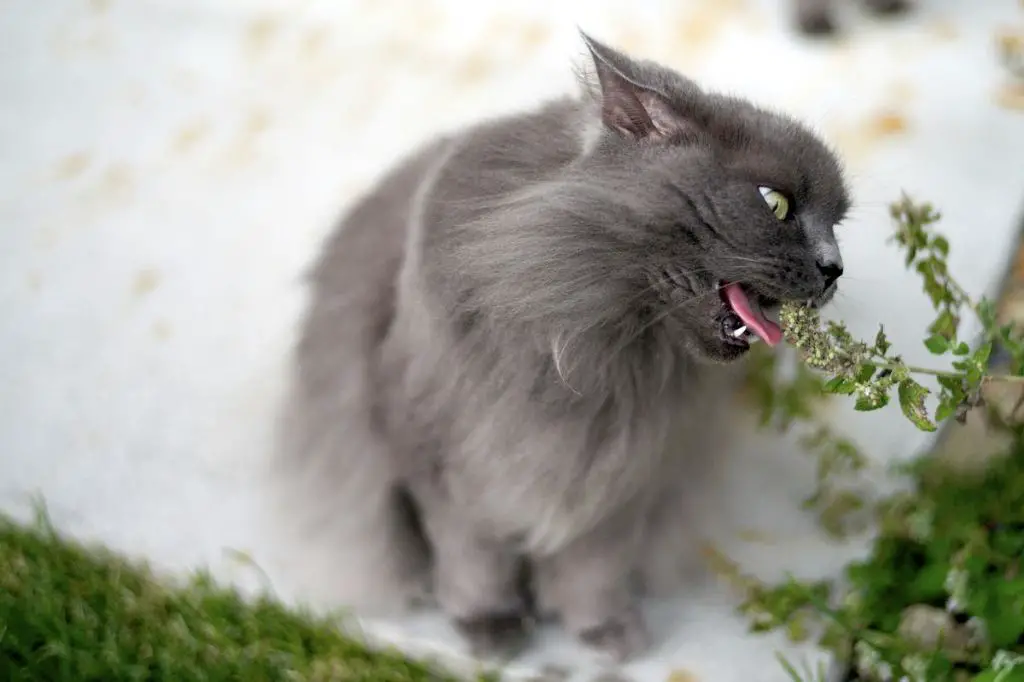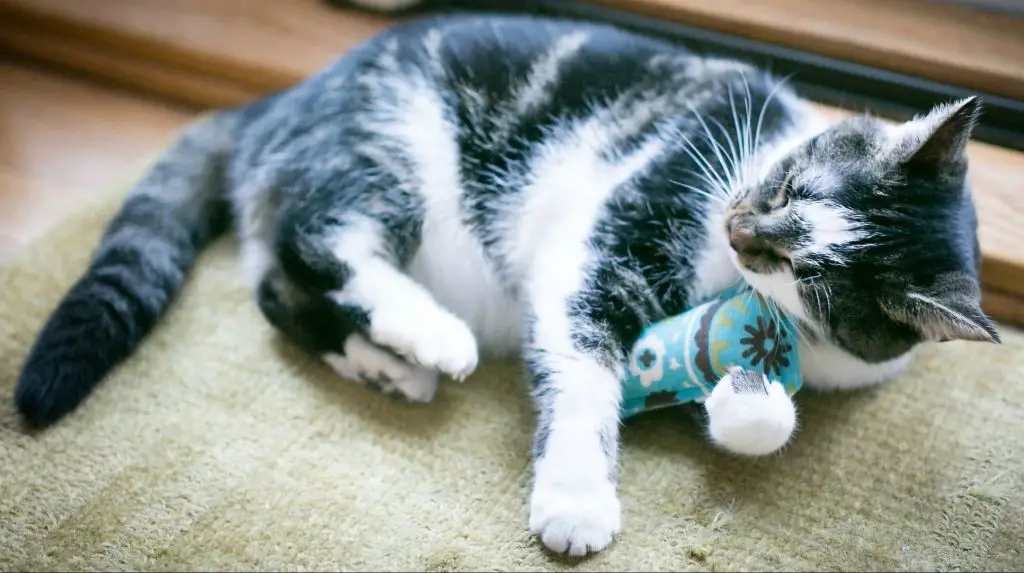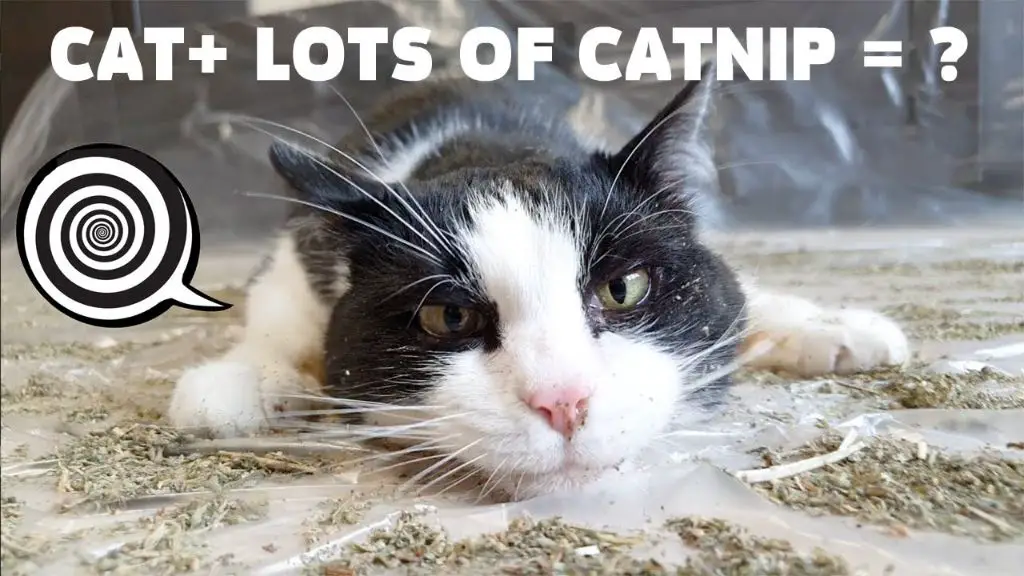What is catnip and why do cats love it?
Catnip (Nepeta cataria) is a herb from the mint family that grows wild in some parts of the world. It has been used for centuries as a medicinal plant for humans, but its effect on cats was only discovered more recently.
The active chemical in catnip that attracts cats is called nepetalactone. When cats smell this chemical, it triggers a response in their brain that makes them act strangely – often described as a temporary euphoric state. Effects on cats can include rolling around, flipping, rubbing up against things, meowing or growling, suddenly sprinting around and jumping, and general hyperactive behavior. The effects usually last for 5-15 minutes before the cat loses interest.
Not all cats react strongly to catnip – genetics determine whether they are easily stimulated by nepetalactone or not. But around 50-70% of cats go wild for the chance to roll around in fresh catnip. It’s still not fully understood why some cats react strongly while others seem immune to its effects.
While the “high” catnip produces in cats may seem similar to drugs, it is actually harmless and non-addictive. For most cats it is an enjoyable experience to have occasionally.

Is it safe for cats to eat/roll in catnip?
Catnip is generally considered safe for cats to eat or roll around in (https://www.petmd.com/cat/general-health/what-is-catnip). The active ingredient in catnip, called nepetalactone, does not cause any harmful effects in cats when eaten or absorbed through the skin. Nepetalactone binds to receptors in a cat’s nose and induces a harmless euphoric reaction that most cats enjoy.
While catnip itself is not toxic, eating too much catnip or rolling in it for too long can cause overstimulation. Signs of overexposure include hyperactivity, drooling, vomiting, and diarrhea. As long as catnip is given in moderation, most cats can safely indulge in nibbling on and rubbing against fresh or dried catnip.
Recommended ways to give catnip
There are several fun and safe ways to give your cat catnip. Here are some of the most popular methods:
Catnip-filled toys – Stuffing catnip into toys is a great way to hold your cat’s interest. Commercial catnip toys like balls and mice are available at pet stores. You can also make DIY catnip toys by filling old socks or paper tubes with dried catnip. According to wikiHow, tying off the end of a catnip-filled sock makes an entertaining cat toy.
Dried catnip sprinkled on scratching posts/cat trees – Sprinkling a pinch of dried catnip on your cat’s scratching posts or cat tree can entice them to use and enjoy these items more often. The smell of catnip will attract your cat while scratching releases more of catnip’s aromatic oils. Just make sure not to overload the area, as too much catnip can be overwhelming, notes Petmate.
Catnip sprays – Spraying liquid catnip extract onto toys or cat beds is another great catnip delivery method. Catnip spray allows you to precisely control the amount used. It also evenly distributes the catnip. According to Dreamie’s Treats, catnip spray brings out the herb’s aromatic quality.
Can I sprinkle loose catnip on the floor?
Sprinkling loose catnip on the floor can provide some benefits for cats, but it does come with some potential downsides to consider:

Pros:
- Loose catnip allows cats to roll around and fully immerse themselves in the scent and effects.
- It’s an inexpensive way to provide enrichment.
- Cats often find loose catnip highly stimulating and enjoyable.
Cons:
- Loose catnip can be messy as cats roll around and track it all over the home (source).
- There are risks if cats ingest too much loose catnip while rolling in it, including vomiting or diarrhea (source).
- The effects wear off quickly as the essential oils evaporate.

Some alternatives to consider are catnip-filled pouches or toys. These allow cats to enjoy the scent while minimizing mess and ingestion risks. But sprinkling some loose catnip occasionally under supervision can be an enjoyable treat for cats.
How much catnip should I use?
The amount of catnip you should give your cat depends on the form of the herb.
For dried catnip, start with 1⁄2 to 1 teaspoon and see how your cat reacts. You can gradually increase the amount up to 1-2 tablespoons.
With fresh catnip, give your cat 3-5 leaves or a sprig about 2 inches long. Fresh catnip is more potent than dried.
Catnip spray can be sprayed onto toys. Use 4-6 squirts to start.
Catnip oils should be diluted before use. Add 1-2 drops of catnip oil to toys or bedding.
It’s important not to give your cat too much catnip. Signs of catnip overexposure include vomiting, diarrhea or hyperactivity lasting more than a few hours. Limit catnip to no more than 2 times per week and adjust the amount based on your cat’s reaction.
How often can catnip be given?
It’s important not to overexpose cats to catnip, as it can cause overstimulation. Experts recommend limiting catnip use to no more than 2-3 times per week.
According to The Effects of Catnip on Your Cat, “It’s recommended to limit the use of catnip with your furry friends to about once every two to three weeks in order to prevent habituation.”
Giving catnip too frequently can cause cats to become desensitized to its effects. It’s best to use catnip in moderation as an occasional treat. Allowing 48 hours between catnip sessions gives your cat’s nervous system time to reset.
Keep an eye on your cat after exposing them to catnip. Signs of overstimulation include hyperactivity, restlessness, and agitation. If your cat seems overstimulated, avoid catnip for a few days until they return to normal.
Signs of Catnip Overexposure
Cats can experience signs of overexposure if they consume too much catnip. The active chemical in catnip, called nepetalactone, can cause various neurological effects when overconsumed. The main signs of catnip overexposure in cats include:
- Agitation and hyperactivity – Cats may become overly playful, hyper, and difficult to calm down. They may run around the house at high speeds or act restless.
- Lethargy and anxiety – Some cats may experience the opposite effect and become very lethargic and anxious after too much catnip. They may hide or seem depressed.
- Gastrointestinal upset – Ingesting too much catnip can cause nausea, vomiting, and diarrhea in some cats.
- Disorientation and lack of coordination – Cats may have trouble walking straight, seem off balance, and bump into objects.
- Dilated pupils – Catnip causes pupil dilation, so overconsumption can lead to extremely dilated pupils.

These neurological effects of catnip overdose usually last about 10-15 minutes before subsiding. If any symptoms persist beyond an hour or cause significant distress, a vet visit may be warranted.
Catnip Alternatives
While catnip is the most popular and well-known cat herb, there are some other safe alternatives that also provide a stimulating, cat-friendly experience for your feline friend:
Silvervine (Actinidia polygama) is a cat plant that originates from Asia and can produce effects similar to catnip in many cats. The active compounds in silvervine are called actinidine and matatabilactone, which interact with feline olfactory receptors and nervous systems much like nepetalactone in catnip. Silvervine products like toys and treats are becoming increasingly popular catnip alternatives.[1]
Valerian (Valeriana officinalis) is an herb known for its calming, mild sedative effects in humans and cats. The active compound is called valerenic acid. Valerian sometimes attracts cats to rub, roll, and sniff it. It may not have as strong of an effect as catnip, but can be a more mellow alternative.[2]
Cat-safe essential oils can also be used aromatherapy for cats. Dilute oils like catnip, silvervine, or valerian in water and either spray or diffuse them. But be sure to research safety, dilute properly, and monitor your cat’s response.
Safety tips for using catnip
When giving your cat catnip, it’s important to follow some safety precautions. Here are some tips:
Store catnip out of your cat’s reach when you’re not directly supervising. Cats can get into open bags or containers and eat more than they should. Keeping it in a closed container in a cupboard or on a high shelf prevents overindulging. Only bring it out when you plan to actively monitor your cat’s interaction with it (source: https://urgentvet.com/catnip-safety/).
Pay attention to your cat’s reaction to catnip. Most cats will play more energetically, roll around, rub their face on catnip toys, and then relax. But some cats may get overstimulated and anxious. If your cat seems distressed or aggressive, take the catnip away and don’t give it again (source: https://www.petcarerx.com/article/is-catnip-safe-5-things-you-should-know/81).
Look for organic catnip that hasn’t been treated with pesticides. This reduces the risk of any contamination. Organic catnip is widely available at pet stores, online retailers, and some supermarkets. You can also grow your own catnip at home in an outdoor garden or pot (source: https://content.petmate.com/academy/the-dos-and-donts-of-catnip/).
The bottom line
In summary, sprinkling loose catnip directly on the floor is not recommended. While catnip is safe for cats, loose catnip can spread everywhere and be difficult to clean up. It’s better to put catnip in toys or contained areas where your cat can enjoy it without making a mess.
The key points to remember are:
- Catnip is non-toxic for cats and causes a pleasant, euphoric effect when smelled or ingested.
- Too much catnip can cause overstimulation and anxiety. Use it in moderation.
- Sprinkling loose catnip on the floor can spread all over and be hard to clean up.
- It’s better to fill toys with catnip or sprinkle it in specific play areas.
- Give your cat access to catnip for 5-10 minutes at a time, 1-2 times per day.
- Watch for signs of catnip overexposure like hyperactivity, drooling, and anxiety.
While catnip can be a fun treat for your cat, it’s best used safely in toys, scratchers, or designated play spaces. Avoid scattering loose catnip to prevent messes and overstimulation.

